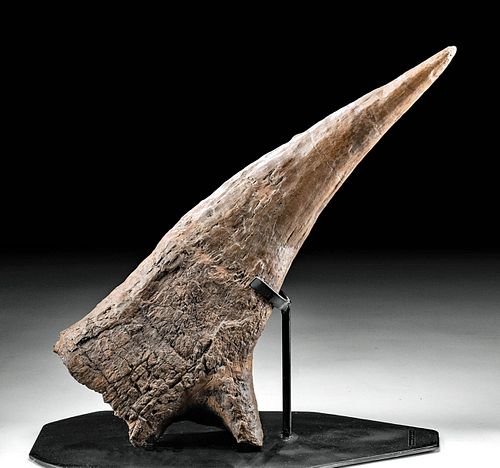Fossilized Triceratops Right Brow Horn w/ Eye Socket
Lot 159
About Seller
Artemis Fine Arts
686 S Taylor Ave, Ste 106
Louisville, CO 80027
United States
Selling antiquities, ancient and ethnographic art online since 1993, Artemis Gallery specializes in Classical Antiquities (Egyptian, Greek, Roman, Near Eastern), Asian, Pre-Columbian, African / Tribal / Oceanographic art. Our extensive inventory includes pottery, stone, metal, wood, glass and textil...Read more
Estimate:
$19,000 - $28,000
Absentee vs Live bid
Two ways to bid:
- Leave a max absentee bid and the platform will bid on your behalf up to your maximum bid during the live auction.
- Bid live during the auction and your bids will be submitted real-time to the auctioneer.
Bid Increments
| Price | Bid Increment |
|---|---|
| $0 | $25 |
| $300 | $50 |
| $1,000 | $100 |
| $2,000 | $250 |
| $5,000 | $500 |
| $10,000 | $1,000 |
| $20,000 | $2,500 |
| $50,000 | $5,000 |
| $100,000 | $10,000 |
| $200,000 | $20,000 |
About Auction
By Artemis Fine Arts
Oct 7, 2021
Set Reminder
2021-10-07 10:00:00
2021-10-07 10:00:00
America/New_York
Bidsquare
Bidsquare : Exceptional Antiquities Ethnographic Fine Art
https://www.bidsquare.com/auctions/artemis-gallery/exceptional-antiquities-ethnographic-fine-art-7537
Museum-worthy examples of Egyptian, Greek, Roman, Etruscan, Near Eastern, Far East / Asian, Pre-Columbian, African / Tribal, Oceanic, Native American, Spanish Colonial, Fossils, Ancient Jewelry, Fine / Visual Arts, so much more! Artemis Fine Arts info@artemisfinearts.com
Museum-worthy examples of Egyptian, Greek, Roman, Etruscan, Near Eastern, Far East / Asian, Pre-Columbian, African / Tribal, Oceanic, Native American, Spanish Colonial, Fossils, Ancient Jewelry, Fine / Visual Arts, so much more! Artemis Fine Arts info@artemisfinearts.com
- Lot Description
North America, Western United States, late Cretaceous Period, ca. 68 to 66 million years ago. This is a fantastic, fossilized brow horn from a triceratops (Triceratops horridus), one of the most famous dinosaurs of the Cretaceous period! This horn projects outward with a slightly curved profile, and from the wide base is a slight projection, forming the upper curve of the right orbital socket! This horn would rest before the flared frill, just above the eyes, perfect for fending off attacks and gouging predators - like modern day bulls. This is arguably the most iconic part of this animal and has beautiful caramel and umber brown hues. Size: 29" L x 12" W (73.7 cm x 30.5 cm); 24" H (61 cm) on included custom stand.
First found in 1887 just west of Denver, Colorado in the town of Morrison by Arthur Lakes and named by Othniel Charles Marsh, these large horned animals were initially mistaken for a form of bison before they realized they represented a type of dinosaur known as a Ceratopsian. The triceratops skull was heavy and distinctive: with three horns, a parrot-like beak, and a frill that could reach three feet wide, it was one of the largest skulls known from any land animal. Interestingly, most horned animals travel in herds, but the triceratops has been found more frequently in individual contexts. Puncture marks on the fossil frills of males of the species show that they used their horns to fight each other, with some paleontologists believing that this was done to impress females. Finds of blood vessels throughout the horns and frills of these animals suggest that they were not just weapons, but were also used for identification of individuals, much like the antlers and horns of modern species like reindeer and mountain goats. These horns grew throughout the life of the animal, especially in childhood and adolescence, along with the skull, which went from one foot long in babies to six feet long in adults. The horns on these babies were only about an inch long.
This piece has been searched against the Art Loss Register database and has been cleared. The Art Loss Register maintains the world's largest database of stolen art, collectibles, and antiques.
Provenance: private Berthoud, Colorado, USA collection
All items legal to buy/sell under U.S. Statute covering cultural patrimony Code 2600, CHAPTER 14, and are guaranteed to be as described or your money back.
A Certificate of Authenticity will accompany all winning bids.
PLEASE NOTE: Due to recent increases of shipments being seized by Australian & German customs (even for items with pre-UNESCO provenance), we will no longer ship most antiquities and ancient Chinese art to Australia & Germany. For categories of items that are acceptable to ship to Australia or Germany, please contact us directly or work with your local customs brokerage firm.
Display stands not described as included/custom in the item description are for photography purposes only and will not be included with the item upon shipping.
#167926Professionally restored and repaired. Repaired from 4 large pieces. Stable fissures and infill to fissures and gaps. Partial eye socket attached and nice coloration throughout.Condition
- Shipping Info
-
All shipping is handled in-house for your convenience. Your invoice from Artemis Gallery will include shipping calculation instructions. If in doubt, please inquire BEFORE bidding for estimated shipping costs for individual items.
-
- Buyer's Premium



 EUR
EUR CAD
CAD AUD
AUD GBP
GBP MXN
MXN HKD
HKD CNY
CNY MYR
MYR SEK
SEK SGD
SGD CHF
CHF THB
THB














